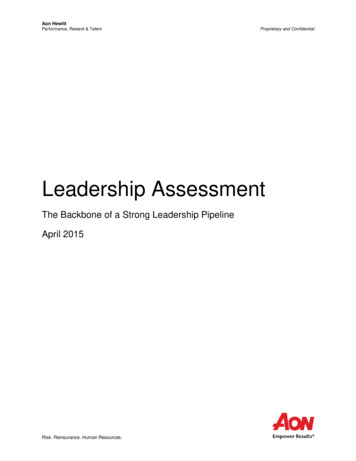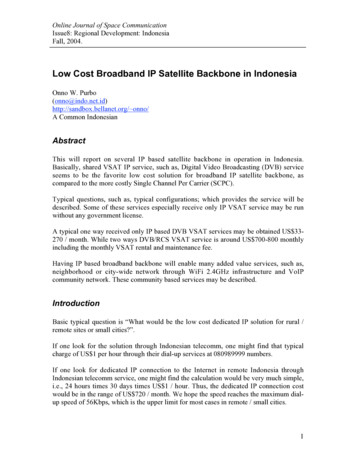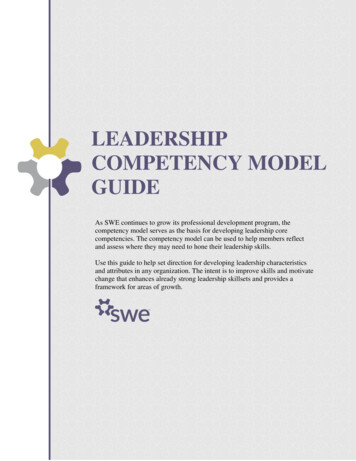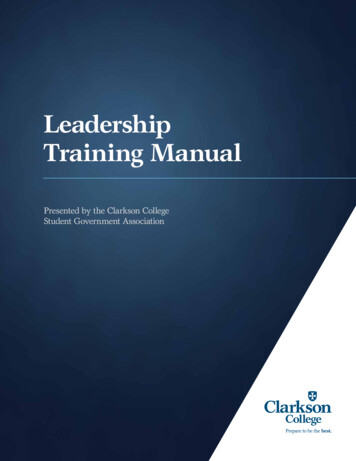
Transcription
Aon HewittPerformance, Reward & TalentProprietary and ConfidentialLeadership AssessmentThe Backbone of a Strong Leadership PipelineApril 2015Risk. Reinsurance. Human Resources.
Aon HewittPerformance, Reward & TalentProprietary and ConfidentialLeadership assessment is the backbone of a sustainable leadership pipeline. However, organizationsoften struggle with determining how to identify leaders with potential, which assessment approach to use,and how to apply assessment results. The Aon Hewitt Top Companies for Leadersresearch reveals that companies known for strongleadership differentiate themselves through apervasive focus on assessment for everyleadership stage, from front-line throughexecutive levels. They also employ a wide rangeof assessment measures and strategicallyintegrate assessment with other talent practices.Using information gleaned from top companies’practices, scientific research, and Aon Hewitt’sextensive practical experience, organizations candramatically strengthen their leadership pipelineby considering six Guiding Principles forleadership assessment.A Strong LeadershipPipeline is Essential toGrowthIn today’s global corporate environment, strongleadership is an organizational imperative, andcompanies must deftly balance their current andfuture leadership needs. Leaders not only ensurethe efficient operations of the organization; theyalso drive performance and influence theircompany’s reputation. A robust leadershippipeline is essential to meeting revenue goals,innovation, engagement, and growth.Despite the need to power a solid leadershippipeline, the current business landscape createsa context in which organizations struggle tosuccessfully fill their talent gaps. The graying ofthe workforce signals the impending retirementwave of the Baby Boomer generation, which willinevitably create leadership vacancies. Further,global economic instability fuels the war for talent,and organizations engage in fierce competition forthe best and brightest while simultaneouslystriving to develop their internal leadership benchstrength. The VUCA (Volatile, Unpredictable,Complex, and Ambiguous) business environmentAon Hewitt Top Companies for LeadersResearchFounded in 2001, the Aon Hewitt TopCompanies for Leaders study is one of themost comprehensive longitudinal studies oftalent management and leadership practicesaround the globe. Our first results, published in2002, demonstrated the link between financialsuccess and great leadership practices, andidentified differentiating elements found only intop companies. The current study, conductedin 2014, marks the eighth iteration of thisfoundational research. The pool of competingorganizations was the most competitive we’veseen to date, demonstrating that even thosethat didn’t make the Aon Hewitt TopCompanies for Leaders list are pushing in theright direction. For additional information, visitour website at aon.com/topcompanies.“The lack of potential leaders is the most pressingHR challenge organizations expect to face.”– Industry Week“85% of executives across the globe agree that thedefinition of effective leadership has changed withinthe current decade.”– Center for Creative Leadership“Mid- and senior-level leaders are viewed as themost critical roles in organizations, yet are also themost challenging to attract and retain.”– Aon Hewitt Top Companies for Leaders Study“Attracting and retaining talent ranks among the top5 most critical risks organizations face.”– 2015 Aon Global Risk Management Survey“Organizations with top-tier leadership teamsoutperform by 18.8%.”– Corporate Leadership CouncilLeadership Assessment—The Backbone of a Strong Leadership Pipeline1
Aon HewittPerformance, Reward & TalentProprietary and Confidentialcreates a pressing demand for leaders who are highly agile and adaptable.Survey after survey indicates that organizations face significant problems in filling key leadership rolesand have grave concerns regarding the adequacy of their leadership pipelines. Aon Hewitt’s TopCompanies for Leaders research on leadership and talent management demonstrates that organizationsthat can successfully drive leadership growth through an emphasis on growing leadership capabilities atall organizational levels thrive despite the challenges in the dynamic global marketplace. Aon Hewitt Top Companies for Leaders Incorporate Assessment at Every Leadership LevelAccording to Top Companies for Leaders findings, top companies possess an acute awareness that theneed to acquire and develop outstanding talent is rapidly intensifying. A key differentiator of topcompanies is an exceptional focus on creating an extensive and integrated leadership pipeline thatincorporates formal assessment strategies for every leadership level, a variety of rigorous assessmenttechniques, and integration of assessment into multiple talent practices.Assessment at All Leadership Levels Fuels a RobustPipelineTop companies recognize that assessment is the cornerstone upon which a sustainable leadershippipeline is built. Not only do world-class companies utilize a range of reliable and valid assessmentmethods, but notably, they also learn from their assessment results. Assessment allows these companiesto generate a full picture of their current leadership abilities, identify gaps in their future leadership, andLeadership Assessment—The Backbone of a Strong Leadership Pipeline2
Aon HewittPerformance, Reward & TalentProprietary and Confidentialformulate targeted development plans for potential leaders in order to fill those holes. Specifically, 100%of global top companies use assessment to identify deficiencies in their leadership skill sets versus only76% of all other companies. In addition, 96% of global top companies implement accelerateddevelopment plans based on these outcomes, compared to 71% of other participating companies.Guiding Principles for Leadership AssessmentClearly, assessment plays a principal role in leadership pipeline development. However, the way in whichorganizations approach assessment, as well as the methods and tools they utilize, significantly impact theeffectiveness of assessment in powering a strong and sustainable leadership bench. As Church andRotolo (2013) point out, many organizations endlessly search for the assessment technique that will bemost fruitful in developing future leaders. Given the vast array of assessment methods available,organizations may struggle to form an assessment strategy, choose appropriate tools, and utilize resultsin an informative and actionable way.Keeping in mind some fundamental guiding principles can help in developing an assessment approachthat is both effective and sustainable. Aon Hewitt’s point of view on leadership assessment is based onthe scientific literature, extensive experience with thousands of organizations, and exposure to thepractices of the Top Companies for Leaders since 2002.Guiding Principle #1: Assess potential to “make the curve” at eachleadership levelTop companies distinguish themselves by their commitment to investing in leaders at all business levelsand their pervasive focus on appropriate assessment at front-line, mid-, and senior executive levels. Aninsufficient pool of leadership talent at lower leadership levels will inevitably lead to limitations in talent athigher levels. Designing and implementing assessments for each crucial curve in the leadership pipelineis an efficient, reliable, objective, and cost-effective way to develop and prepare internal talent for theirnext leadership step.Kaiser and Bartholomew (2011) point to the importance of creating tailored assessment plans for everystage of the company hierarchy. In their novel empirical study, the authors illustrated that uniqueleadership capabilities are required at each leadership level. These results indicate that organizationscannot rely solely on previous performance to understand the capacity for lower-level managers tosuccessfully fill more senior-level leadership positions. This study conveys how necessary assessmentsare to obtain an accurate evaluation not only of current leadership capabilities but also the potential to“make the turn” at subsequent steps in the pipeline.Therefore, an important step in planning for assessment is to define the competencies required forsuccess at each leadership level, particularly those competencies needed to “make the curve” at keycareer transitions. Assessment instruments that specifically measure these competencies can then bedeveloped and implemented.Leadership Assessment—The Backbone of a Strong Leadership Pipeline3
Aon HewittPerformance, Reward & TalentProprietary and ConfidentialCharan’s classic leadership pipeline model describes six key leadership stages and the criticalcompetencies that individuals must cultivate in order to successfully transition to each subsequent stage(Charan, Drotter, and Noel, 2001). Assessing individuals against these competencies will then yieldimportant information regarding areas in which future leaders need to develop in order to be ready for thatnext level. By focusing on the capabilities needed for the upcoming phase of the leadership journey,assessments can effectively evaluate a leader’s potential for success in future stages of the pipeline.Assessment information can then guide leaders’ development so they will be prepared to performeffectively at the next level.IBM, a consistent Top Companies for Leaders winner for the past 15 years, recognizes the need forassessment at all levels. Its talent practices include a regular evaluation of leadership capabilities forthose currently in leadership roles as well as evaluation of leadership potential and the functional skills ofIBMers globally. The results of these assessments are then used to guide potential career paths andpersonalized development plans for each IBM leader.Interestingly, Top Companies for Leaders analyses reveal that organizations that devote resources toassessment at all levels reap financial benefits. Companies that conducted assessments at seniorleadership levels had 15% higher relative performance in profitability than companies that did not.Moreover, companies that conducted assessments at mid-leadership levels had 35% higher relativeperformance in profitability. A closer look at the relationship between assessment and financial outcomesshows that a significant relationship exists between delivering assessments at the mid-leadership leveland CAGR Earnings Before Interest and Taxes (EBIT), an important financial index of company growth.Companies with a high utilization of assessments at the mid-leadership level showed a 133% increase inCAGR EBIT compared to those with a low utilization rate.Assessment Drives Financial Results: Relationship between Mid-Level Assessment and CAGREBIT.077 CAGR EBIT130%Increase.084 CAGR EBIT133%Increase-.26 CAGR EBITLowMediumHighLevel of Assessment at Middle LevelLeadership Assessment—The Backbone of a Strong Leadership Pipeline4
Aon HewittPerformance, Reward & TalentProprietary and ConfidentialAdditionally, in contrast to all other companies, Aon Hewitt Top Companies for Leaders repeatedlyemphasize the inclusion of front-line managers within their assessment practices. In fact, all otherorganizations reported difficulties in developing front-line managers, and 76% of all other companies(versus 56% of global top companies) responded that their talent pipeline at the front-line level wasinsufficient for future success.Guiding Principle #2: Align assessment practices with organizationalstrategy and contextEnsuring a close compatibility between organizational strategy and assessment practices is a centralfeature that demarcates top company winners from all the rest. Eighty-eight percent of global topcompanies report that their leadership assessment practices are explicitly aligned with organizationalstrategy, compared to only 41% of all other companies.A common mistake in designing leadership assessment and development programs is failing to take intoaccount the context and unique challenges faced by the organization. Scientific findings (e.g., Vroom andJago, 1995) and practical experience repeatedly indicate that leadership behaviors and styles aredifferentially effective depending on the situation. In fact, a recent McKinsey article (2014) specificallynotes “overlooking context” as one of four key reasons that leadership development programs fail.The culture of the region in which the organization is located, the organizational culture and climate, theindustry, the economic situation, and the organization’s financial state are just a few examples of contextthat can impact organizational strategy and, consequently, the leadership skills needed in thatorganization. For example, an organization making a strong effort to globalize will likely emphasizeleadership capabilities such as cultural adaptability and possession of a global mindset. This organizationwill need to orient its talent practices appropriately so it can assess and develop leaders on those corecompetencies.Guiding Principle #3: Use a variety of valid, objective assessmenttechniquesThe use of multiple valid methods to assess defined competencies is an integral part of an assessmentapproach. Scientific research has discussed the benefits of using multiple methods for decades (e.g.,Nunnally, 1978; Groth-Marnat, 2009; Scott and Reynolds, 2010). However, organizations often make themistake of depending on too few methods for assessment. Different measures better assess particulartypes of competencies. For example, distinct tools exist that best evaluate personality, cognitive ability,motivation, and behavior.Additionally, more precise results can be reached when multiple measures are used to assess the sameset of competencies. Converging the results of multiple instruments with regard to leadershipcompetencies can lead to enhanced developmental feedback, career planning, and improved reliabilityand validity overall. When these results diverge, a deeper dive into the reasons behind any discrepanciescan afford more profound insight into development opportunities. Top Companies for Leaders findingsclearly reveal that global top companies are more likely than other companies to employ a variety ofassessment techniques across all leadership levels. Many of the top companies discussed their use of360s, cognitive ability tests, personality tests, interviews, and other tools in assessing leaders.Leadership Assessment—The Backbone of a Strong Leadership Pipeline5
Aon HewittPerformance, Reward & TalentProprietary and ConfidentialTop Companies Employ a Variety of Valid Assessment ToolsThe accuracy (validity) of the methods used to predict future performance is of critical importance.Organizations may use assessment results to determine which employees are categorized as top talent,which of them receive certain developmental opportunities, and which are ultimately promoted into moresenior leadership roles. If the assessment methods are not accurate in forecasting performance,organizations may allocate time and resources toward developing employees who are unsuitable forfuture leadership positions, and overlook others who should have been included. This process would leadto wasted organizational efforts and be unfair to employees. In addition, validity is essential to the legaldefensibility of the process and is required under EEOC guidelines when assessment information is usedto make employment-related decisions.Leadership Assessment—The Backbone of a Strong Leadership Pipeline6
Aon HewittPerformance, Reward & TalentProprietary and ConfidentialAssessment Centers that Integrate Multiple Techniques are Particularly ValidAssessment centers that employ multiple assessment methods have been shown to be particularly strongpredictors of leadership performance (Arthur et al., 2003; Becker et al., 2011; Hermelin et al., 2007;Thornton and Gibbons, 2009). This approach has been used for decades and was popularized by thelandmark Management Progress Study done at AT&T in the late 1950s. With a conventional assessmentcenter, participants are invited to a physical location where they complete a number of assessments.Assessment centers may include tests of personality, motivation, and cognitive ability, all of which can bestrong predictors of leadership performance (Barrick and Mount, 1991; Huffcutt, 2011; Schmidt andHunter, 1998).Guiding Principle #4: Integrate assessments across talent practices, withcompetencies as the common denominatorNotably, top companies are characterized by their seamless integration of assessment into talentpractices. Specifically, top companies strategically and explicitly incorporate assessment with other talentpractices, particularly leader development, high potential identification, and coaching.Leadership Assessment—The Backbone of a Strong Leadership Pipeline7
Aon HewittPerformance, Reward & TalentProprietary and ConfidentialCompetencies Provide a Common DenominatorOne hundred percent of global top companies responded that their assessment and developmentprocedures were explicitly aligned, versus 64% of all other companies. While other companies may havesimilar talent practices in place, their practices often operate in isolation from one another. In contrast, topcompanies exhibit an unparalleled cohesiveness among their leadership and talent practices thatultimately enables the promotion of a powerful leadership pipeline.Leadership Assessment—The Backbone of a Strong Leadership Pipeline8
Aon HewittPerformance, Reward & TalentProprietary and ConfidentialIntegration Creates Rhythm for Assessments Across Talent PracticesTop Companies for Leaders winner ArcelorMittal provides a good example of intimately linkingassessment, high potential identification, and development. When high potentials are nominated, they areput through a robust leadership assessment process to validate their selection as high potentials. Thosewho pass this assessment (approximately 80%) are appraised in terms of succession planning, and anindividual development plan aligned with their succession options is formulated.A fundamental practice underlying this integration is the mapping of assessment tools to competencies. Acomprehensible competency model clearly conveys the organization’s vision for leadership and impartswhich leadership competencies are most important to the organization. Mapping of assessments tocompetencies helps ensure coverage of those competencies most important to the organization. Further,communication is enhanced when assessment results are presented in the common language of thecompetency model. Employees receive feedback in a consistent and standard format, and can betterunderstand the competencies on which they need to focus in order to progress.Intel Corporation, ICICI Bank and Sime Darby Berhad are a few examples of Top Companies for Leaderswinners that report having a defined leadership competency model and applying that model within theirtalent practices. Moreover, top companies are more likely than all other companies to use competencybased assessments for the purposes of leadership development, coaching, and high potentialdevelopment among all leadership levels, ranging from front-line to senior management.Leadership Assessment—The Backbone of a Strong Leadership Pipeline9
Aon HewittPerformance, Reward & TalentProprietary and ConfidentialFor example, Intel outlines its expectations, competencies, and behaviors for leaders. Expectations aredivided into three major categories: grow the business, lead our people, and execute with urgency. Eachis supported by a list of specific competencies (e.g., building organizational capability; strategicorientation) and a set of descriptive behaviors. Leaders are measured against these expectations on anannual basis using multiple approaches.Early identification, assigning responsibilities ahead of time, and providing perspectives from varieddomains are the salient features of ICICI Bank’s leadership potential assessment and developmentprocesses. These practices ensure creation of a leadership bench equipped to deal with adaptivechallenges. ICICI Bank has defined a set of leadership competencies (“DNA Anchors”) that guideemployee behavior and serve as the foundation for all people processes like recruitment, performancemanagement, learning and development, succession planning, etc. The leadership potential assessmentprocess is designed to select individuals for distinguishing strengths rather than to exclude forshortcomings. The 360-degree feedback process is based on the DNA Anchors, and is used as an inputfor individual leadership potential assessment as well as for the individuals’ own development.Incorporating defined leadership competencies into talent practices, including assessment, isunquestionably a best practice as well as a trademark of top companies. In line with this idea, TopCompanies for Leaders analyses demonstrate that the extent to which organizations integrate theirleadership competencies is significantly related to whether or not they are classified as top companies.There is also significant correlation with several financial indicators of growth and return (CAGROperating Income over Five Years; Operating Income Percentile Rank within Industry; CAGR EBIT overFive Years; EBIT Percentile Rank within Industry).Impact on Profitability: Integration of Competencies and CAGR EBIT.103 CAGR EBIT-.004 CAGR EBIT148%Increase98%Increase-.216 CAGR EBITLowMediumHighDegree of Integration of CompetenciesLeadership Assessment—The Backbone of a Strong Leadership Pipeline10
Aon HewittPerformance, Reward & TalentProprietary and ConfidentialGuiding Principle #5: Aim to make assessments realistic and engagingParticipants garner valuable information from the assessment tools and procedures that organizationsemploy. Based on the types of assessment methods used and the way in which those methods areadministered, participants form reactions and perceptions regarding the organization’s values and culture(Gilliland, 1993; Truxillo and Bauer, 2011). Participants can even gain insight into a particular position,and subsequently use that information to ascertain whether that position would be the best fit for them(Truxillo and Bauer, 2011).Participants’ reactions and attitudes can significantly impact their motivation to perform their best duringan assessment (Gilliland, 1993). When participants are fully motivated and focused during assessment,they are more likely to exert effort and showcase their true skills—thus allowing the organization to gain amore accurate picture of their abilities.Further, participant reactions reflect their attraction to and intentions toward the organization. This notonly lends weight to participants’ commitment to and satisfaction with the organization (Truxillo andBauer, 2011), but also impacts the way in which participants discuss the organization with others and theextent to which they recommend the organization to others. Therefore, assessment tools and proceduresadditionally have the power to shape an organization’s brand and reputation (Bruk-Lee, Drew, andHawkes, 2013).It is widely accepted that participant reactions are noticeably enhanced when they perceive theassessments to be job-related and valid and feel as if they have a fair opportunity to perform (Gilliland,1993). When assessments are engaging and realistic, participants are much more likely to feel as if thereis a strong connection between what they are asked to do in the assessment and the actual abilitiesneeded for the job. As participants are asked to exhibit job-relevant behaviors in a realistic assessment,such as a work sample or simulation, they are also more likely to feel as if the assessment provided themwith the fair chance to display applicable competencies.Because participant reactions to assessments can have such considerable implications, it is imperative tounderstand the way in which participants experience different types of assessments. For example, trendstoward gamification and the use of other innovative technology in the assessment domain have forced thequestion of how participants respond to this novelty. Recent research has shown that reactions totechnologically innovative assessments have been consistently positive (Pommerich and Burden, 2000;Tuzinski et al., 2012). Bryant and Malsey (2012) explain that participants particularly favor multi-mediaassessments.Guiding Principle #6: Ensure assessment processes are practical andsustainableA hallmark of top companies is that leadership practices are institutionalized. Flexibility, efficiency, andscalability are essential to the long-term sustainability of assessment processes. Assessment tools mustbe flexible enough to appropriately align with the organization’s competencies, language, and businesscontext. Further, flexibility in assessment delivery, administration, cost, and reporting is essential toestablishing assessment procedures that can practically span geographical location and organizationallevel. Tools should balance the need for remote versus face-to-face administration, provide efficientadministration processes for participants and administrators, and minimize travel expenses that don’t addLeadership Assessment—The Backbone of a Strong Leadership Pipeline11
Aon HewittPerformance, Reward & TalentProprietary and Confidentialvalue. Given a globally dispersed workforce, many organizations must be able to implement assessmentsin globally diverse locations, and with minimal administration requirements.To assess all leadership levels in an organization, assessments must be scalable given the volume offront-line and mid-leadership level positions this likely entails.In terms of reporting, the type of output that results from the assessment process can significantly impactits usefulness and long-term acceptance within the organization. Generating assessment results quicklyand providing the data in formats that can be used for multiple purposes increases the return oninvestment made in assessment. For example, being able to tailor reports toward specific purposes—such as selection versus development, for participants versus managers, or summarized versus detailedin format—is very valuable.Long-term sustainability requires efficient incorporation of assessment results into multiple practices. Forinstance, it is vital that results be efficiently linked to developmental planning for future leaders in mostsituations. In fact, world-class companies recognize that the links between assessment and developmentmust be strong. Compared to 49% of all other companies, 72% of global top companies report that theyuse assessment data to inform developmental plans.In a discussion of formal assessment practices in large, high-functioning organizations, Church andRotolo (2013) highlight the need for consistency and interrelatedness among assessment anddevelopment strategies. They point out that greater consistency with regard to strategy, approach, andtools will reduce complexity and facilitate the incorporation of assessment data into developmental efforts.Top companies purposefully connect leadership assessment and development in their companies. In linewith their focus on in-role development, one global top company explained that its leaders completeassessments at two points in time: first, a substantive assessment for leaders entering a new leadershipgroup to guide development planning over the course of the new role; second, a “Mid-AssignmentLeadership Assessment” for all leaders every three to four years to guide ongoing development andprovide input to talent reviews. The format of the assessments varies by leadership group, but includes asa common component a structured 360 review based on the company’s corporate leadership attributes.As alluded to in the aforementioned case, assessment results can be used for more than just individualdevelopmental purposes. For example, the results of a 360 assessment can inform strategic developmentopportunities for individuals and also be included in talent review and succession planning processes bynoting the strengths and areas of opportunity required for readiness. The ability to efficiently leverageleadership assessment information hinges on strong data management systems that allow access toinformation when it is needed, yet at the same time ensure the appropriate level of confidentiality.Leadership Assessment—The Backbone of a Strong Leadership Pipeline12
Aon HewittPerformance, Reward & TalentProprietary and ConfidentialLeadership Assessment Guiding Principles - Highlights1. Assess potential to “make the curve” at each leadership level.2. Align assessment practices with organizational strategy and context.3. Use a variety of valid, objective assessment techniques.4. Integrate assessments across talent management practices, with competencies as the commondenominator.5. Aim to make assessments realistic and engaging.6. Ensure assessment processes are practical and sustainable.Organizations that align their assessment strategies with the Guiding Principles outlined above arepoised to excel in leadership assessment. As described, many top companies exemplify theseGuiding Principles in their assessment techniques and approaches. The development andimplementation of a strong assessment plan that spans organizational levels, is compatible withorganizational strategy and culture, and operates in tandem with other talent practices will enableorganizations to build and fortify a durable leadership pipeline.Leadership Assessment—The Backbone of a Strong Leadership Pipeline13
Aon HewittPerformance, Reward & TalentProprietary and ConfidentialContact InformationVeronica S. Harvey, Ph.D.PartnerPerformance, Rewards and TalentLeadership Services 1.832.476.5747veronica.harvey@aonhewitt.comYael Oelbaum, M.S. and M.PhilAssociatePerformance, Rewards and T
Leadership Assessment—The Backbone of a Strong Leadership Pipeline 4 Charan’s classic leadership pipeline model describes six key leadership stages and the critical competencies that individuals must cultivate in order to successfully transition to










